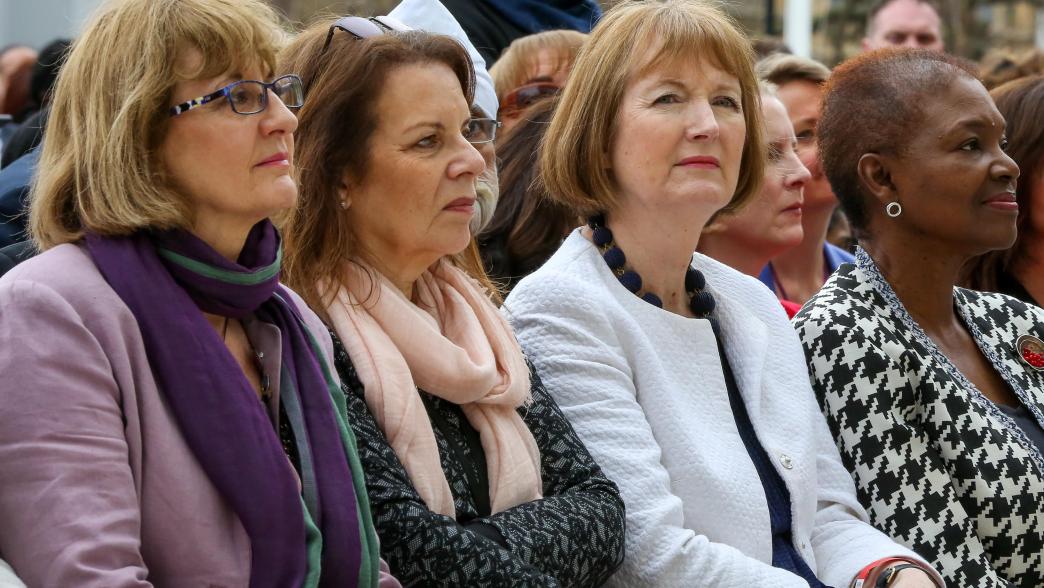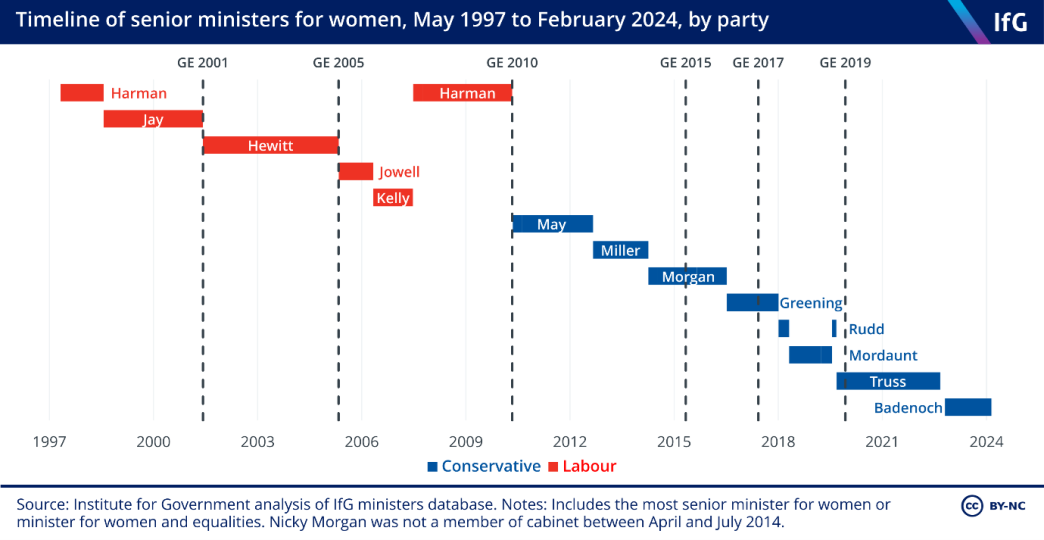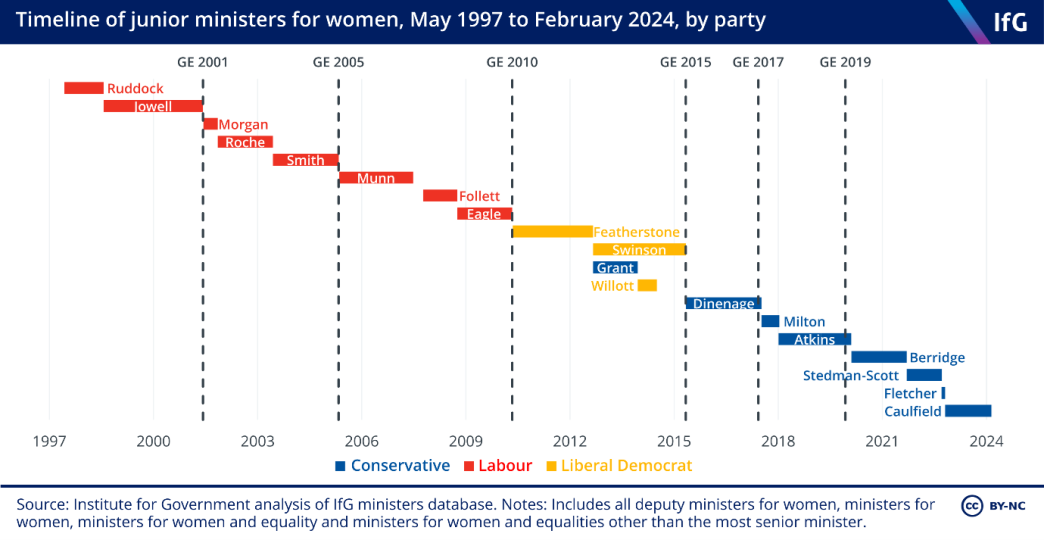Minister for women and equalities
Who is the minister for women and equalities and how has the role developed over time?

Who is the minister for women?
Since 1997, each prime minister has appointed a senior member of the government as minister for women, or minister for women and equalities. The current minister for women and equalities is Kemi Badenoch, who is also the secretary of state for business and trade.
The minister for women and equalities leads the Government Equalities Office (GEO) in the Cabinet Office, and is supported by three junior ministers who hold equalities-related responsibilities in the GEO in addition to their main ministerial jobs. Currently these are:
- Maria Caulfield, minister for women and a parliamentary under-secretary of state in the Department of Health and Social Care
- Stuart Andrew, minister for equalities and a junior minister in the Department for Culture, Media and Sport
- Mims Davies, minister for disabled people, health and work (a role shared with the Department for Work and Pensions)

What does the minister for women do?
The GEO leads on equality-related issues across government. Ministers in the GEO are responsible to parliament for this agenda, including answering oral questions and appearing before the Commons Women and Equalities Committee.
The day-to-day work of the minister for women has varied over time, reflecting the differing priorities of each minister and the competing demands of their main departmental work. Harriet Harman – the first to hold the role – told the Institute for Government that she chose to focus on childcare, domestic violence and female representation. Lynne Featherstone, a junior minister for women during the coalition government, spoke about her focus on body confidence and the campaign against female genital mutilation (FGM).
Some have focused on legislation: Tessa Jowell described her involvement in the EU negotiations that laid the basis for the Equalities Act 2010. Others have used the convening power that ministerial office allows to encourage change: Justine Greening spoke of her efforts to ‘convene and corral and motivate change on the ground, working with loads of amazing civil society actors’ on issues like FGM and forced marriage.

How has the role of minister for women developed?
Since the minister for women was created in 1997, to lead the newly established Women’s Unit in the Cabinet Office, the role has developed considerably. 31 Abrams F, ‘Harman heads team to put women’s issues first’, The Independent, 3 June 1997, retrieved 28 February 2024, www.independent.co.uk/news/harman-heads-team-to-put-women-s-issues-first-1254053.html Harriet Harman, the first to be given the role, recalled how comparatively little status was given to it at the time: her private office in her main role in the Department of Social Security simply told her ‘Oh, by the way, you’re the person in the Cabinet responsible for women and equalities as well. There is this Women and Equalities Office, located in some other department, and they will be coming over here.’
This was not helped by the Women’s Unit moving department several times during its early years, often (but not always and never immediately) moving to the department of its lead minister.
By 2007, the minister for women had gained responsibility for equalities more generally and the unit was renamed the Government Equalities Office. The GEO was made a ministerial department in its own right in that year and the pattern of churn stopped for a time. By then, Harman had returned to the role and recalled: ‘there were a whole load of civil servants who were committed to it. They actually wanted to go into it – they weren’t just people who had been pushed out of other government departments.’
This arrangement didn’t last however: ministers announced in December 2010 that the independent department would be wound down and the GEO relocated to the Home Office (where then minister for women and equalities, Theresa May, was based). 32 Government Equalities Office, Annual Report and Accounts, 2010–11, July 2011, p. 5 From then on, it returned to its earlier itinerant pattern, moving from department to department in pursuit of its minister. Jo Swinson told the Institute for Government that this ‘was a bit ridiculous … machinery of government changes are hugely disruptive to the employees and just take a lot of energy’.
By 2018, the minister for women and equalities (then Penny Mordaunt) was based at the Department for International Development, her junior ministers at the Home Office, and her civil servants at the Department for Education. 33 Women and Equalities Committee, The role of Minister for Women and Equalities and the place of GEO in government, 5 June 2018, HC 356, p. 7. In April 2019, following a recommendation by the Commons’ Women and Equalities Committee, the GEO moved to its new permanent home in the Cabinet Office. 34 Government Equalities Office, ‘Government Equalities Office to join Cabinet Office’, 16 November 2018, https://www.gov.uk/government/speeches/government-equalities-office-to-join-cabinet-office
How effective is the role of minister for women?
The Women and Equalities Committee has noted that the minister for women and equalities can exert a wider influence within cabinet, ensuring that women’s experiences are represented at the top of government. 35 Women and Equalities Committee, The role of Minister for Women and Equalities and the place of GEO in government, 5 June 2018, HC 356, p. 11. Justine Greening told the committee that her role involved being ‘sharp‑elbowed across government to make sure that other departments also reflect the importance’ of the equalities agenda. 36 Women and Equalities Committee, Oral evidence: The work of the Government Equalities Office, 18 January 2017, HC 933, Q22
The extent to which this actually happens is unclear. The committee warned in 2018 that the GEO had no formal role in overseeing the work of other departments. 37 Women and Equalities Committee, The role of Minister for Women and Equalities and the place of GEO in government, 5 June 2018, HC 356, p. 10. Helen MacNamara, former deputy cabinet secretary, later told the Covid-19 inquiry that women were regularly excluded from decision making during the pandemic and that female experience was ignored. 38 Helena MacNamara, Witness Statement of Helen MacNamara, UK Covid-19 Inquiry, 9 October 2023, 99–107 MacNamara warned separately that the inclusion of ‘women’ as an issue on the cabinet agenda once a year risked giving the false ‘impression that the rest of the agenda was for men’. 39 Helena MacNamara, Witness Statement of Helen MacNamara, UK Covid-19 Inquiry, 9 October 2023, 100
The fact that the ministers for women perform their role alongside an additional departmental portfolio can also act as a barrier to progress. Nicky Morgan felt that ‘there was a real danger that women and equalities would get squeezed out’ by her concurrent responsibilities as education secretary. Similarly, Maria Miller argued that there ‘were never enough hours in the day’ to balance her DCMS portfolio with the women and equalities brief, ‘because you could do either of those jobs alone and it would still be a huge job to do.’
The Women and Equalities Committee have suggested that the role should become ‘a standalone brief in its own right’. 40 Women and Equalities Committee, The role of Minister for Women and Equalities and the place of GEO in government, 5 June 2018, HC 356, p. 10.
- Topic
- Ministers
- Keywords
- Cabinet Diversity and inclusion
- Public figures
- Kemi Badenoch
- Publisher
- Institute for Government